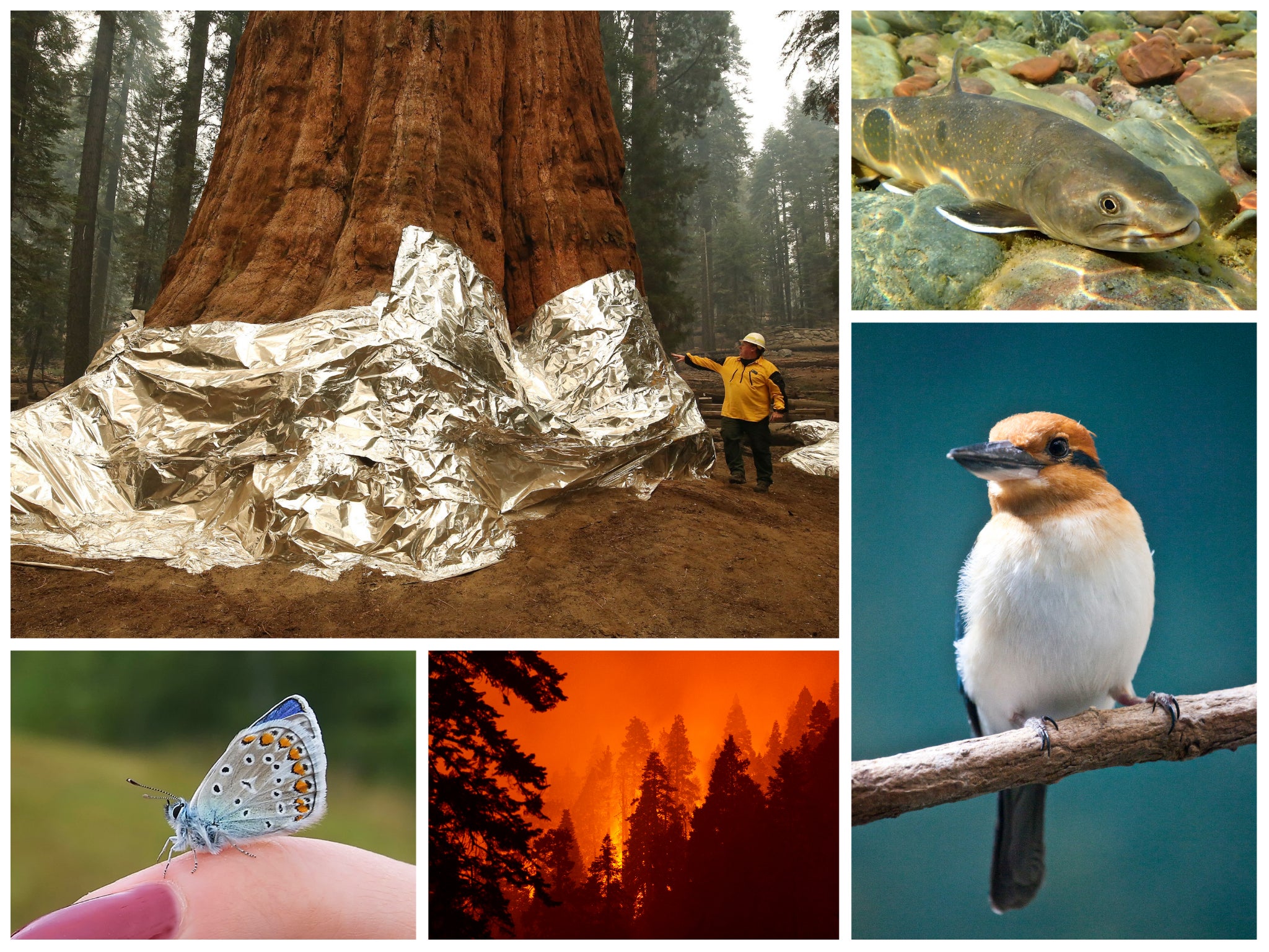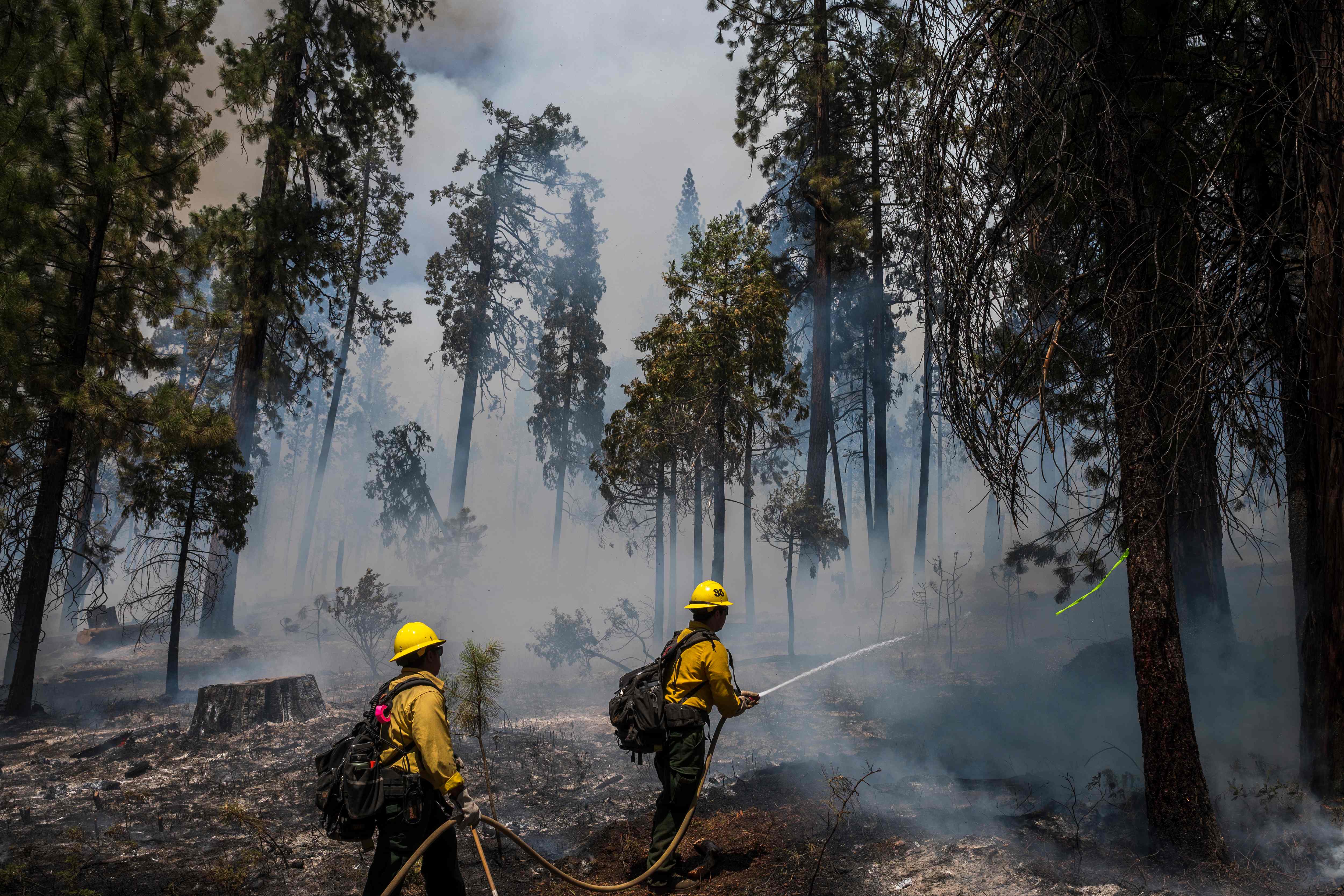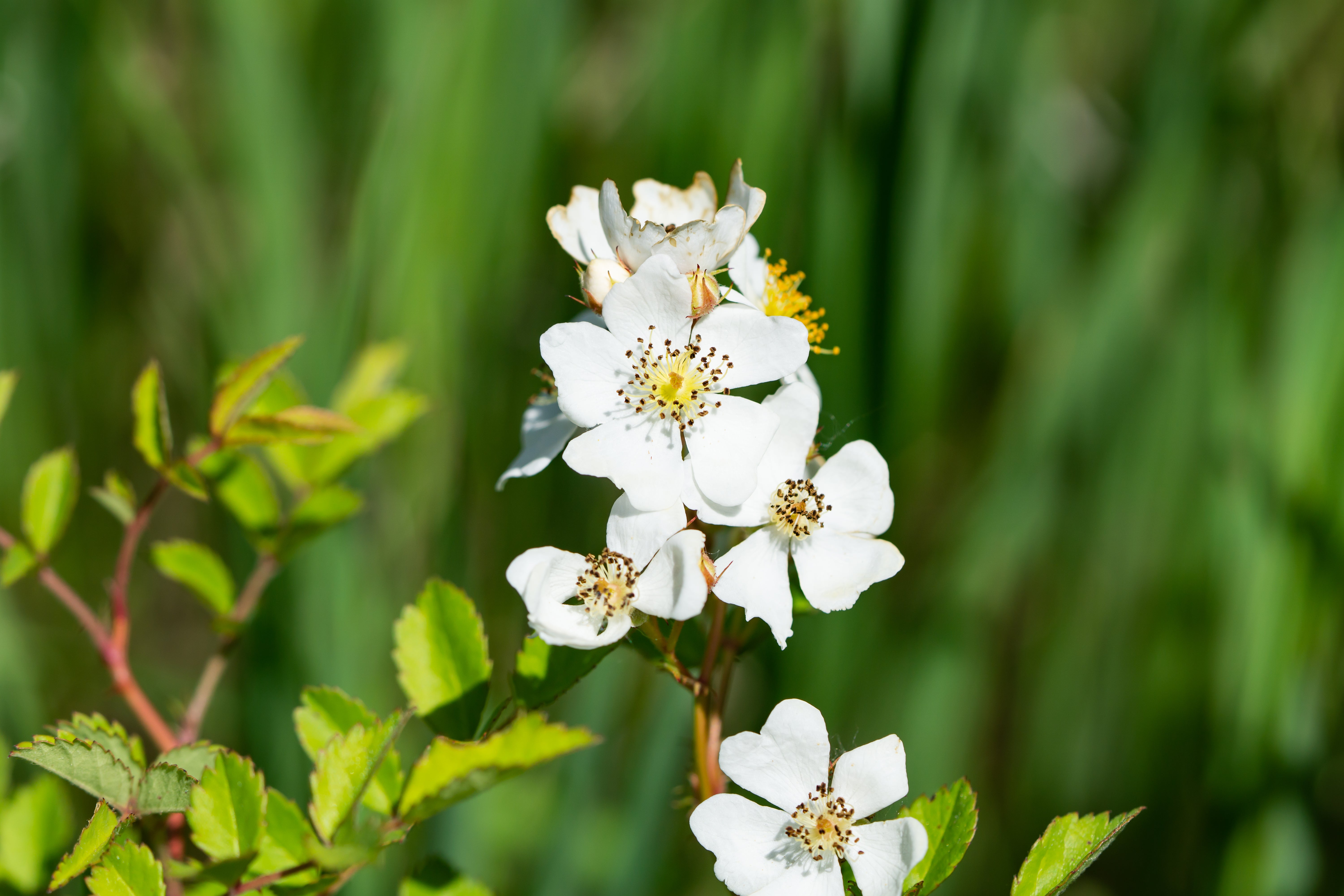The controversial plan to help wildlife outrun climate disaster
The climate crisis is already threatening the long-term survival of many species. Climate reporter Ethan Freedman looks at the benefits - and risks - of relocating plants and animals to new homes

In 2020, King Arthur died in a fire.
The 270-foot giant sequoia, named after the British royal of legend, is the species’ ninth-largest, and one of the largest living things on the planet.
But when the Castle Fire swept through the southern Sierra Nevada mountains that September, this towering behemoth burned.
The blaze in 2020, plus the vast KNP Complex the following year, felled up to 13,000 giant sequoias – about 19 per cent of the species in the Sierras, their only native home.
As the climate crisis makes wildfires larger and more frequent, these icons of the California mountains are expected to face even more catastrophic blazes.
Some plans to save the Sierra’s sequoias are already underway. To protect the trees from flames, officials have been wrapping them in foil or deploying sprinklers at the base.
Forest managers also use controlled burns to reduce potential fire fuel like dead trees, downed branches and dried-out leaves. In the long run, reducing the carbon emissions that are making the planet hotter and drier would help.
Some conservationists are considering a much more direct, and drastic, approach: moving the giant trees to places where they might not face as many climate threats.
Welcome to the world of “managed relocation” – when conservationists, like the biblical Noah, gather members of a threatened species and move them to relative safety.
This summer, supporters of managed relocation got a big boost when the US Fish and Wildlife Service (USFWS) proposed changes to the Endangered Species Act which would allow the federal government to establish new populations of threatened species outside of where they’ve historically lived.
In addition to the sequoia, managed relocation has been proposed – and even attempted – for the Guam kingfisher, bull trout, and the American pika, a small mountain mammal, along with an endangered conifer, the Florida torreya.
The proposal raises serious questions including how the strategy might unwittingly create new invasive species and harm native populations.
But the climate crisis is already driving mass extinctions with an estimated one million plants and animals at risk, according to the United Nations.
It leaves scientists with a dilemma: What lengths will they go to save wildlife, even if it flies in the face of traditional ideas about conservation?
“We have this idea that nature does best if you leave it alone,” Jessica Hellmann, an ecologist at the University of Minnesota tells The Independent.
“Here we’re saying nature might actually need people to intervene on their behalf. And that makes people very uncomfortable.”
For decades, two main goals in conservation biology were to keep wildlife in its natural habitat and restore wildlife to where it once belonged.
There have been great success stories like the revival of bald eagles across North America and the return of wolves to Yellowstone National Park.
But that calculus changes when you throw in the consequences of a rapidly-heating world.
Sea-level rise, droughts and wildfires, for example, are changing habitats — and rendering coastlines, forests and mountains less habitable for the wildlife that calls them home.
Take the giant sequoia. Wildfires are a natural part of the Sierra Nevada ecosystem, and the trees are incredibly well-adapted. They even rely on regular burns for their seeds to sprout.
But decades of humans suppressing fires, coupled with insufficient forest management, has left downed branches and vegetation that burns easily. Combine that with ever drier and hotter conditions, and wildfires now burn with unprecedented ferocity and size.
Christy Brigham, a resource manager at Sequoia and Kings Canyon National Parks in California, tells The Independent that she’s concerned about the impact on sequoias from drought, fire and a local bark beetle.
Her team is working to figure out what’s driving the new beetle threat in the sequoias. However, attacks from a different bark beetle on ponderosa pines in the Sierras have been linked to hotter temperatures.
While sequoias aren’t on the federal endangered species list, which would exclude them from the USFWS rule being debated, Dr Brigham and her colleagues have discussed managed relocation for the trees nonetheless.
There’s still a lot to figure out before the National Parks Service would actually start moving trees - like what aspects of the climate crisis threaten the sequoias the most.
Regardless of questions that remain, some conservationists have already started planting the giant trees away from the Sierra range.
David Milarch, whose family has been in the tree nursery business for generations, is the founder of the Archangel Ancient Trees Archive. For more than 25 years, the non-profit organisation has taken cuttings from trees like giant sequoias and replanted over the world, in part to clone some of the oldest trees alive.

Mr Milarch tells The Independent that giant sequoias, as well as coast redwoods, a sister species, have been planted from the US Pacific Northwest to the United Kingdom.
Mr Milarch notes that planting these giant trees can also benefit the climate. Each full-grown sequoia can store hundreds of tonnes of carbon, keeping it out of the atmosphere where it would help warm the planet.
As the climate crisis ravages more of the natural world, more species will face trouble and may become candidates for managed relocation. USFWS highlighted the plight of the Mount Rainier ptarmigan, a bird facing threats as its mountainous home in the Pacific Northwest heats up.
USFWS is also considering establishing a population of the Guam kingfisher, a bird native to the South Pacific island, on a new island. The kingfisher was driven extinct in the wild by an invasive snake, and less than 200 of the birds live in captivity.
But while managed relocation holds the promise of survival for a species on the edge, plenty can go wrong.
For one, it’s expensive, Dr Hellmann says. The climate crisis is projected to threaten almost a third of all species by the end of the century, so at best, managed relocation would be a selective solution, she adds.
“Do we think we’re going to go along and do managed relocation species by species by species to address a third of total biodiversity? No,” she explains.
And even if some limited relocation succeeds, it might work too well. Moving species to new locations may risk them over-running that new habitat.
Dan Simberloff, an ecologist at the University of Tennessee, tells The Independent that USFWS’s new embrace of managed relocation is “potentially disastrous”.
“About half of substantial biological invasions begin with planned introductions of one sort or another,” he said.
Dr Simberloff says that the multiflora rose, a shrub native to Asia, was introduced across the US to control erosion in the 1930s. It has since spread widely and invaded habitats of native plants, as well as lands used for cattle and agriculture.
The rusty crayfish, native to the Ohio River watershed, was introduced to rivers in other parts of the country because it’s great bait for fishing, Mark Schwartz, an ecologist at UC Davis, adds. Now, it’s spread widely and displacing other crayfish species.
On the other hand, plenty of species have been moved without becoming invasive or harming native wildlife – for example, the giant sequoia.
There are ways to try to predict the likelihood of trouble from an invasive plant or animal. Species moved within North America might have a lower risk of invasion than species moved from other continents, Dr Hellmann says. But there isn’t zero risk – biological invasions from one spot in North America to another have still occurred, she adds.
Mostly, it’s hard to predict with certainty which species will become invasive and which won’t, Dr Simberloff says.
“Things that seem like they’re likely going to be innocuous turn out to be disasters, on the one hand, and things that you might have predicted would cause problems sometimes don’t,” he says.
There’d be enough irony in turning a threatened species into an invasive one. But the potential complications go even further.
Dr Hellmann has studied the possibility of relocating the Karner blue butterfly, an endangered insect from the northeast and midwestern US.
She isn’t concerned about the butterfly going rogue, but when it’s still a caterpillar, it can only eat one species of plant, the wild blue lupine. So for the Karner blue butterfly to succeed in a new habitat, those plants would need to be relocated too – and lupines can add excess nitrogen to the soil, which could mess with local plant species, Dr Hellmann says.

There are plenty of possibilities for failure. But in a crisis, you sometimes need to take a risk.
“Because of climate change, there are consequences,” Dr Hellmann says. “You can’t just ignore those consequences, you’re obligated to respond to them, even if it means you’re considering something that you would never otherwise consider.”
Dr Hellman, Dr Schwartz and their colleagues have compiled a set of criteria to evaluate the potential risks and benefits of managed relocation.
First is the question of feasibility. Can you realistically establish a new population of a threatened species? Is it even legal?
Second, will the new population be socially acceptable? For example, cheetahs may be threatened with extinction but you might face resistance to introducing them to suburban Ohio.
Third, what is the likelihood of causing harm, like creating a new invasive species, or damaging the existing population in its original habitat?
Lastly, and perhaps most importantly, how necessary is drastic action? Managed relocation isn’t something you do haphazardly – it’s a Hail Mary pass to save a species with no other options.
For the giant sequoia, conservationists know that they can survive in other parts of the world. They also know that the risk of becoming invasive is low. In terms of social acceptability, trees are pretty benign.
But is it really necessary?
As the climate crisis worsens, California faces more wildfires. One study last year found that the Sierra Nevadas could face 50 per cent more fires by the 2040s if emissions continue to rise.
The state, and the rest of the US West, remains in the grips of a two-decade “megadrought” which is being exacerbated by the climate crisis.
California’s forest managers are ahead of the curve in taking measures to protect the giant trees. This summer, more than 500 mature sequoias were saved in Yosemite National Park’s famous Mariposa Grove as the Washburn Fire burned through the area. Officials cited prior controlled burns as one reason they avoided disaster.
With sequoias now planted all over the world, the species isn’t likely to go extinct any time soon, Dr Schwartz says.
But with a species that can live for thousands of years, “soon” may not mean sometime in the next few decades.
“No one wants to go to Sequoia National Park and see a bunch of 10-year-old trees that are eight feet tall. They want to see massive trees,” Dr Schwartz says.
If we want to preserve those massive trees, we’ll want to create new groves at least a couple hundred years in advance, he says — which involves thinking about what the climate might look like at least a couple hundred years in advance.
“So, when are we running out of time with giant sequoias? You know, now I don’t really know,” Dr Schwartz adds.
“Maybe we already have.”
Join our commenting forum
Join thought-provoking conversations, follow other Independent readers and see their replies
Comments


Bookmark popover
Removed from bookmarks